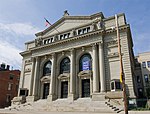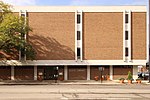Washington Park (Cincinnati, Ohio)

Washington Park is bounded by West 12th, Race and Elm Streets in the Over-the-Rhine neighborhood of Cincinnati, Ohio, United States. The park is owned and operated by the Cincinnati Park Board. The 6-acre (2.4 ha) park served as Presbyterian and Episcopal cemeteries before it was acquired by the city from 1858 to 1863. The park has an old-fashioned bandstand and many trees. Several American Civil War cannons and busts of Civil War heroes Frederick Hecker and Colonel Robert Latimer McCook, who commanded the German 9th Ohio Infantry (Die Neuner) are in the park. There is also a bronze tablet (1931) given by Sons and Daughters of the (Die Neuner) 9th O.V.I. The Centennial Exposition of the Ohio Valley and Central States was held at the park in 1888. It was, in addition to the celebration of Ohio's progress, designed to celebrate the settlement of the Northwest Territory. The park stands in the shadow of the Cincinnati Music Hall. While the now-demolished Washington Park School was located at its north end, a new School for Creative and Performing Arts currently stands across Twelfth Street at its south end.
Excerpt from the Wikipedia article Washington Park (Cincinnati, Ohio) (License: CC BY-SA 3.0, Authors, Images).Washington Park (Cincinnati, Ohio)
Cincinnati Over-the-Rhine
Geographical coordinates (GPS) Address Nearby Places Show on map
Geographical coordinates (GPS)
| Latitude | Longitude |
|---|---|
| N 39.108889 ° | E -84.5175 ° |
Address
Cincinnati, Over-the-Rhine
Ohio, United States
Open on Google Maps








